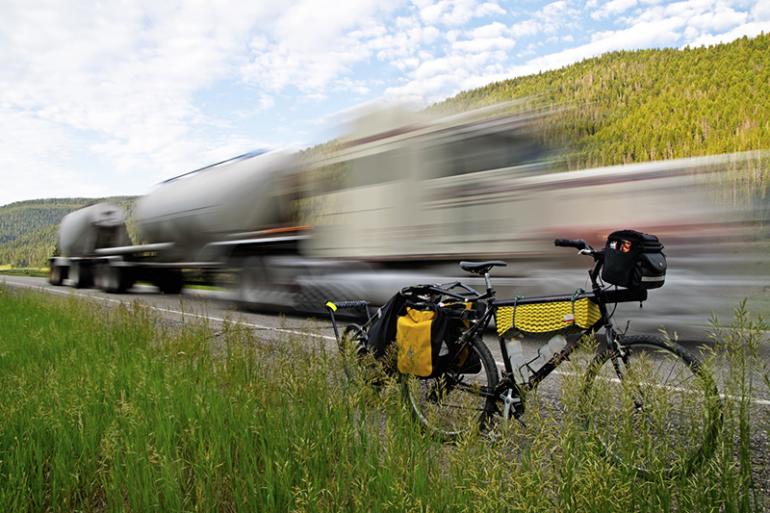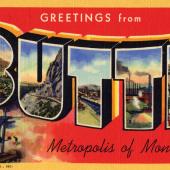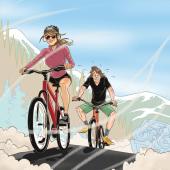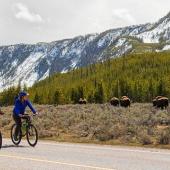Gallatin Garbage
Pick-up day has come to the river.
The bugle of a distant elk echoed through the valley as I watched my ride-share drive away, leaving me where the Gallatin River meets Hwy. 191 just inside Yellowstone National Park. I've had the pleasure of fishing the Gallatin for nearly 20 years, and my first couple fly casts were on this river. My sincerest way of saying thanks to it—the trout, the flora and fauna, and even the adjacent highway—was to bike the 142 miles of the river's length, picking up trash.
As I left the pull-off where the Gallatin meanders down from its source, my efforts immediately became overwhelming. Cigarette butts, beer cans, and auto-accident shrapnel dotted the roadside. The Gallatin flows 14 miles in Yellowstone National Park, and within that stretch alone, I collected one full household garbage bag of waste. But as I came to a section of highway without a turnout or obvious piece of garbage, I simply enjoyed the ride. That stretch allowed me to feel the coming fall; hear the sandhill cranes gawking at the weirdo on a bicycle; and watch the river oxbow where the banks allowed. Setting up camp just before the thunderheads prepared their concert, I found my rhythm for the trip within the riffles, grasping my fly rod as the river bounced down the boulders and into the evening.
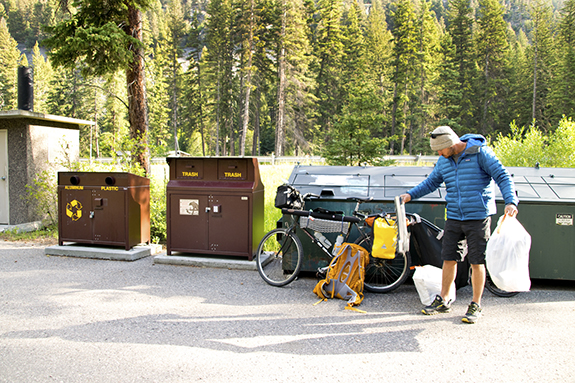
Even in Yellowstone, the trash piles up
The next morning, I drank one cup of coffee after another, hesistant to leave camp. With only six miles until Big Sky, I was in no rush, and strolled out of camp somewhere around midday. Big Sky's rich and famous offered a glimpse of glamour, but I focused on the river. The deep pools' mesmerizing pull is similar to stumbling upon your own personal gold mine: full addiction symptoms—pupils dilated, thoughts racing. However, this section's beauty makes it popiular, and difficult to tidy. The river rolled on, green-lined with trees, but the shoreline was littered with the discarded pleasures of our taste buds.
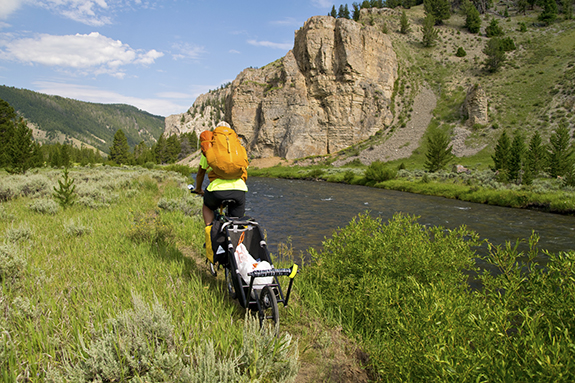
Near Big Sky, trash runs through it
A dirt turnout veered westward off the highway toward the river, a stretch of water hidden from the masses, untouched by the hordes of traveling anglers and families passing me, inches away at times. The thunderheads made another appearance. I was able to set up my rod, but not cast, as the downpour began and so did the lightning. I’m not a fan of swinging graphite in the air while Mother Nature is throwing spears down from the heavens. So I pulled the bike and gear under a tree and made another pot of coffee, waiting out the rain.
As the storm passed, I pedaled off, winding, twisting, and turning with the ebb and flow of the river, following it home for the night. Upon arrival, the campground was empty; I chose whichever site I wanted. A fishless afternoon, I simply sat on the river's edge, watching it roll down the canyon over cobble. An osprey called down the canyon as it echoed throughout the river and straight into my ears, caressing me to bed.
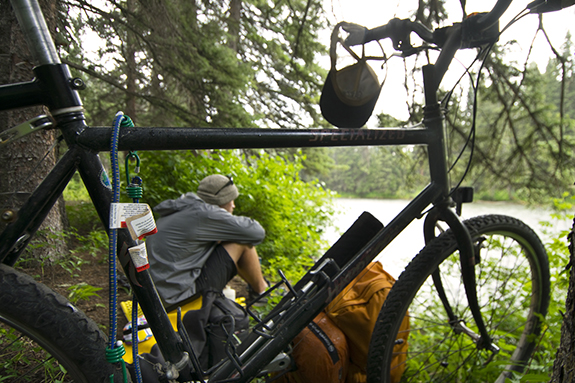
Waiting out the rain along the Gallatin
The rumors about the next section of highway were terrifying. No guardrail or shoulder, with blinding curves hiding you in plain sight from the long-haul truckers. I decided to pedal this section on a Monday, during rush hour. A poor choice, but if I was to reach Missouri Headwaters State Park 50 miles on, where the Gallatin meets both the Jefferson and Madison rivers to form the Missouri, I had to get an early start.
So it was a sunrise cup of coffee, a quick trash dump at the campground bin, and off I went, dodging several-ton pieces of metal powered by gasoline and rubber. They came in waves. A line of about ten cars, coupled with two or three semi-trucks or campers mixed in. I could almost wait out the rush for a few minutes and start back up once the wave crashed over. But there was an urge inside me to charge these miles and get onto the dirt road snaking along the river, just outside the canyon.
On a few curves, I cranked the gears up and went for it until the guardrail gave way to shoulder. Twice, lifted diesel pickups flipped me off as if I was the reason holding up traffic. If there had been another ten miles of highway similar to that, I might have gotten hit or into a fight with the third pissed-off truck. Finally, I made out the mouth of the canyon and bolted to it. Smiling, I veered off down the bumpy dirt road. It went all the way to Four Corners, with only a few access points along the way. The towering cottonwoods n between masked the many bends and pools of the lower Gallatin.
I had never laid eyes on this section of the river. The road curved away from the river but gained elevation, granting me the gift of sweeping views of the Bridger Range and the continuing flow of the river I’d been chasing for two days. At a high point near Gallatin Gateway, I took a break. The drastic change in the landscape became apparent. There I was, perched in elevation, gazing at the gloriousness of the Gallatin, trapped by the confluence of wealth and the natural environment, within old and new Montana money. The land was populated with million-dollar homes, not with grazing livestock or flocking wildlife.
This section of the river is, unfortunately, one of inaccessibility. Private land gobbles up river access like a trout feeding during a summer hatch. Since leaving the canyon, I'd passed only five real access points where I could fish. Naturally, with so few public spots, they're overcrowded, overfished, and littered with trash. I sadly ended up not fishing the rest of the trip, given the amount of garbage to pick up. At one point, as I leaned down to pick up a candy wrapper on the shore, I noticed a few trout nestled on the river bottom, seeking out cool spots. And there lay the trip's lesson: humans can destroy virtually everything, at least on the surface; but Mother Nature is resilient. If we allow her to be, at least.
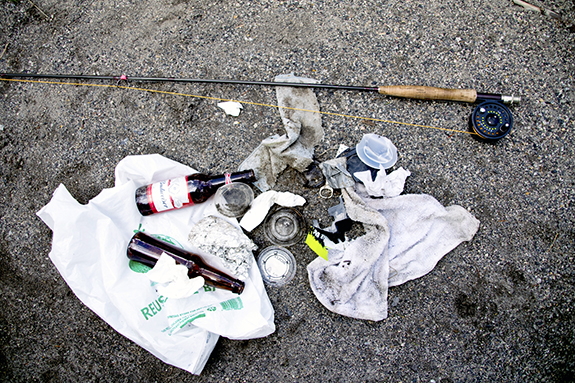
The other way to catch a limit on the Gallatin
Finally, I made my way to the beginning of the Missouri River. The last few miles offered some relief to my saddle-sore rear end, and from the threat of being run over. My final turn was at the convergence of the Jefferson and Madison rivers, but I pedaled one more mile down to where the Gallatin comes in. The slow bends of the final stretch begged for a fly, but no fish were even remotely interested in what I was offering. So, I unrolled the sleeping pad and watched the sun set below the headlands, waiting for my ride to come and take me home.
Overall, I collected three large garbage bags full of rubbish, plus a popped raft. Sadly, I know that my efforts left only a tiny rock chip in the never-ending shatterproof windshield that is the insurmountable garbage pile accumulating along the Gallatin River.
I returned to some of the spots a week later in my car to see what effect I'd had. Alas, my efforts were in vain—everything I picked up had been replaced by a new round of rubbish. I am uncertain what needs to be said or done to correct our collective laziness and stubborn love of disposable containers, but what I do know is that we should all be grateful. Grateful that nature is as resilient as she is, for if she weren't, the Gallatin wouldn’t be what it is today.

